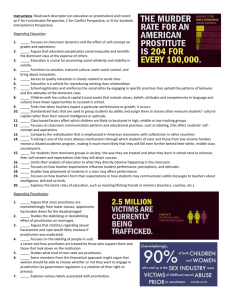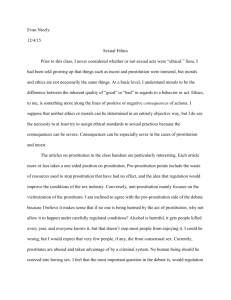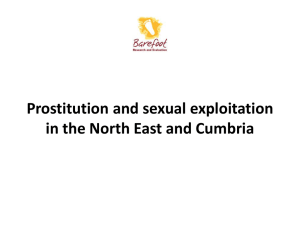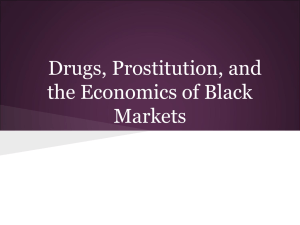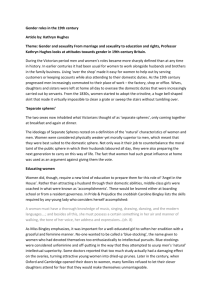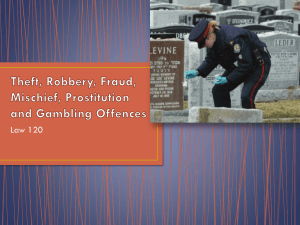Regulatory Approaches to Prostitution
advertisement
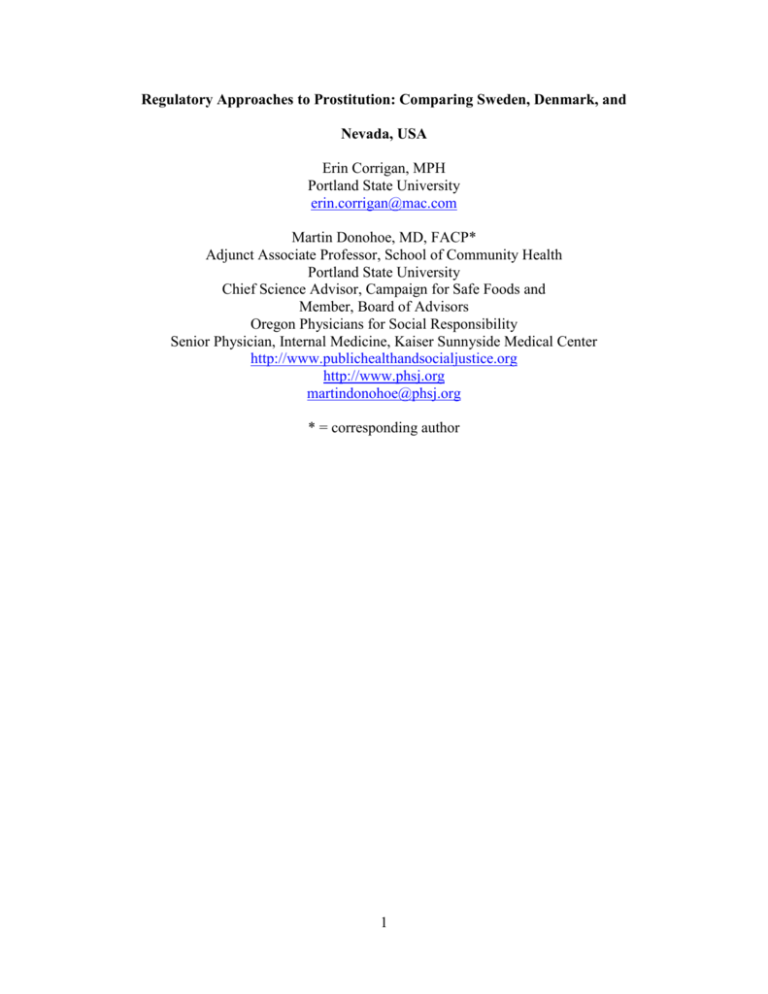
Regulatory Approaches to Prostitution: Comparing Sweden, Denmark, and Nevada, USA Erin Corrigan, MPH Portland State University erin.corrigan@mac.com Martin Donohoe, MD, FACP* Adjunct Associate Professor, School of Community Health Portland State University Chief Science Advisor, Campaign for Safe Foods and Member, Board of Advisors Oregon Physicians for Social Responsibility Senior Physician, Internal Medicine, Kaiser Sunnyside Medical Center http://www.publichealthandsocialjustice.org http://www.phsj.org martindonohoe@phsj.org * = corresponding author 1 Regulatory Approaches to Prostitution: Comparing Sweden, Denmark, and Nevada, USA Abstract Some prominent feminists believe that prostitution is a nonconsensual form of human rights violation and should be criminalized; prostitute advocacy groups favor decriminalization; and some public health professionals and feminists advocate legalization. Sweden, the Netherlands, and the U.S. state of Nevada have approached the issue of prostitution in three different ways. Focusing on women’s health, human rights, and social justice, this paper will examine these governments’ responses to prostitution, including the effects of different legal and regulatory approaches on sex workers. 2 Introduction The long history of prostitution is evident in its clichéd description as the oldest profession in the world. However, many question whether it is a profession or in fact a pervasive form of sexist exploitation. Prominent feminist researchers believe that in all cases prostitution is a nonconsensual form of human rights violation and should be criminalized and, ideally, abolished. They argue that by legalizing or otherwise regulating prostitution, the state becomes the pimp profiting off the suffering and sexual exploitation of women. Such feminists urge the abolition of all aspects of the sex industry, from strip clubs and peep shows to prostitution. On another side of the debate are prostitute advocacy groups such as COYOTE (Call Off Your Old Tired Ethics) that push for decriminalization, under which sex workers, customers, and others involved in the sex industry are not prosecuted or regulated at all and prostitutes can unionize to improve pay and working conditions. They see sex work as a legitimate, even liberating way for women to choose to make a living. A third viewpoint advocates legalization, including state licensing and regulation. This perspective claims advocates among public health and feminist researchers, because it offers prostitutes more legal protection, including protection from unscrupulous brothel owners and dishonest police officers, than they would have under the other models. Legalization also creates an environment in which the spread of disease is limited by regular monitoring. 3 Sweden, the Netherlands, and the U.S. state of Nevada have approached the issue of prostitution in three different ways. Academic and governmental research provides significant data regarding these three approaches. Focusing on women’s health and social justice, this paper will examine these governments’ responses to prostitution, including the effects of different legal and regulatory approaches on sex workers. The Demographics of Prostitution Many believe that it is possible for adult women to freely choose to enter into prostitution, though this idea has been challenged by antiprostitution activists. Proposed myriad reasons sex workers are unable to choose prostitution willingly include drug addiction (Sterk, 2000), poverty (Farley, Baral, Kiremire, & Sezgin, 1998; Farley & Kelly, 2000), and fear of violence from a pimp (Silbert & Pines, 1981). Some equate adult prostitution with human trafficking and child prostitution and see prostitution as sexual abuse (Raymond, 2004). While sex trafficking and child prostitution are unquestionably illegal, exploitative, and socially unjust, others question whether, under certain conditions, prostitution may be consensual (Brents & Hausbeck, 2005; Weitzer, 2005a; 2005b; 2007). The Supply: Epidemiology & Economics The fact that prostitution is illegal in most countries and in almost all of the U.S. states makes accurate collection of demographic data difficult. When data are available they tend to concern street prostitutes rather than indoor prostitutes (Ambesjö, Eriksson, & Lidholm, 2004). In 1999, the average number of prostitutes in the Netherlands was 1 to 2 per 1000 population (Netherlands 4 Ministry of Foreign Affairs, 2004), though in Sweden the figure was much lower, with 2500 prostitutes in a total population of 8.5 million, or 0.3 per 1000 (Kilvington, Day, & Ward, 2001). The Swedish National Criminal Investigation Department estimates approximately 1,000 persons each year are involved in commercial sex in Stockholm and its surroundings (United Nations General Assembly Special Session on HIV/AIDS, 2008). The age range of street prostitutes in Sweden is wide and depends on the city; average age in Stockholm is somewhere between 30 and 45 years (Ambesjö, Eriksson, & Lidholm, 2004). The majority of U.S. data derives from city-level case studies of street prostitutes and may not be representative of the nature and/or scope of prostitution nationwide. One survey of 59 New York City street prostitutes found that the average age was 26 and that one-third were African-American (Coston & Ross, 2004), while a much-cited study of 200 San Francisco street prostitutes found that 70% were under age 21 and 69% were white (Silbert & Pines, 1981). Coston and Ross reported that the average time New York City street prostitutes had worked was 31 months (2004). In Nevada, an estimated 300 licensed prostitutes work in 25–30 legal brothels (Warnick, 2008). Nearly all research shows that economics lies at the heart of women’s decisions to enter into prostitution; some see this as a signal that prostitution always arises from inequity and exploitation (Farley et al, 1998; Farley & Kelly, 2000), for if they had other options, surely women would choose a different line of work. However, it is possible that women choose prostitution because it offers more money for fewer hours than other forms of work (Warnick, 2008). This kind 5 of rational choice perspective, borrowed from economics theory, states that individuals always make choices in their own best interests. In the Netherlands in 2006, prostitutes earned an average of 1100 euro per week. Earnings ranged from 528 euro /week for massage parlor prostitutes to 1460 euro /week for window prostitutes (Dekker, Tap, & Homburg, 2006). The 2006 adult minimum wage was 218 euros /week, so even the lowest paid Dutch prostitutes were making well above minimum wage. As independent contractors in legal brothels, Nevada’s prostitutes set the prices for their work, so income varies. Take-home earnings have been estimated at $300 to $1500 per day (Albert, 2001). In Sweden, earnings vary by location, ethnicity, and social position of the prostitute and include rates of $250-$370 per hour, $150 for intercourse, and $85 for sexual massage (Eriksson & Gavanas, 2008). The Demand: Epidemiology & Economics Recent literature on customers of prostitutes is as polemic as that on sex workers, generally falling into what Monto and McRee (2005) term the “everyman perspective, [which] implies that the customers of prostitutes are no different from men in general…. [and] the peculiar man perspective, [which] implies that customers of prostitutes are characterized by social or personal deficiencies” (italics in original). Monto and McRee feel that the truth lies somewhere between these extremes. The men in their studies who patronized street prostitutes shared certain similarities (e.g., more likely to be unmarried or unhappily married, more sexually liberal) to a small extent, but they were not inherently more likely to be deviant or “psychologically inadequate” than men 6 who did not visit prostitutes. However, given that a small percentage of men report ever having visited a prostitute (between 13% and 16% in the countries described in this paper; Leridon, van Zessen, & Hubert, 1998; Lewin et al, 1998; Michael et al, 1994), patronizing prostitutes is in itself unusual behavior that sets such men apart. Surveys of American men who have ever frequented prostitutes reveal motives that include the need for intimacy and an inability to meet their sexual needs outside of prostitution, perhaps due to their unmarried or unhappily married status (Monto & McRee, 2005). Daalder reported that in the Netherlands “almost nothing is known about the motives of clients” (2007, p. 34), and cited an online study by SOAIDS, a national institute for the control of sexually transmitted infections (STIs) and Acquired Immunodeficiency Syndrome (AIDS) in the Netherlands, which identified three types of clients: one that just wants sex, another that has a “troublesome attitude” toward prostitutes, and a third that seeks intimacy. Note that a troublesome attitude was not explicitly defined, but included an aversion to condoms and an unwillingness to pay for prostitutes’ services; violence was not mentioned. The incidence of violence of all types experienced by prostitutes varies widely from one study to another, and data may be subject to selection bias (Weitzer, 2005a). For example, in a survey of 854 male and female prostitutes in nine countries, 71% reported ever experiencing physical assault (Farley et al, 2003). On the other hand, in a survey of 40 female brothel prostitutes in Nevada, only one reported ever experiencing violence during brothel work, even though 7 most felt that safety (particularly the risk of STI) was a constant concern (Brents & Hausbeck, 2005). Violence is more common among streetwalking prostitutes (Silbert & Pines, 1981; Raphael & Shapiro, 2004). A minority of men are the perpetrators of violence; the majority of clients are nonviolent (Monto & McRee, 2005). Anti-prostitution activists strongly disagree with this position, maintaining that all prostitution is a form of violence against women and that regardless of the venue or their legal status, prostitutes experience significantly higher rates of violence and abuse than do women in general. Such activists’ definition of violence includes verbal abuse and some aspects of sex work, such as spanking, which may in fact be consensual and an agreed-on part of the job (Raphael & Shapiro, 2004; Raymond, 2004). Furthermore, there is a high prevalence of selfharming behaviors and suicide among prostitutes in the U.S. and abroad (Greene et. al., 1999; Hong et. al., 2007; Shahmanesh et. al., 2008). Regulatory Approaches to Prostitution Prostitution has been treated in a variety of ways by different societies: abolition seeks to eliminate prostitution but prosecutes only third parties, such as pimps and clients; decriminalization treats prostitutes as independent contractors, not regulated by the state nor punished by authorities; legalization puts prostitution under state control and regulation; and criminalization, the dominant approach found in most of the U.S., attempts to eradicate prostitution and subjects all parties involved to penalties. The goals of all these approaches are twofold: to protect the women themselves from violence and to protect society at large from “socially corrosive 8 behavior” (Brents & Hausbeck, 2005, p. 273). Preventing the spread of STIs and improving public health are related goals, whether they are achieved by eliminating prostitution or by mandating safer sex practices and condom use. Human Immunodeficiency Virus (HIV) infection can be spread through contact with sex workers, who are often denied health services and support because of the illegal, often invisible nature of their work (Joint United Nations Program on HIV/AIDS; UNAIDS, n.d.) or are unable to access care because they lack health insurance. Where prostitution is illegal, prostitutes’ reluctance to access medical care creates a dangerous position for themselves and a potential threat to public health (McKay, Campbell, & Gorter, 2006; UNAIDS, n. d.), which can be alleviated by legalization (Steen, 2001). Nevertheless, some researchers believe that prostitution will always be abusive to women and anything short of abolition is detrimental to their health and well-being (Farley, 2004; Raymond, 2004). Sweden In 1998 the Riksdag, or Swedish parliament, passed a modified abolitionist law that made it illegal to purchase sex in Sweden beginning January 1, 1999. Prior to that, it was illegal to buy or sell sex. Under the new law, prostitutes may solicit clients for profit, but brothels, profiting from others’ sex work, and advertising prostitution remain banned (Penal Code Chapter 6, Section 11). The law is intended to put the burden of (and blame for) prostitution on the customers, rather than on the prostitutes themselves, and grew out of the work of the government’s Commission on Violence Against Women. The law presumes that men are generally the clients and women the sex workers, and it is intended 9 to reduce violence against women and male demand for commercial sex. The penalty for purchasing sex is a fine of about US$1000-2000 or up to six months in prison (Galiana & Subhan, 2000). However, the law does not increase punishments for trafficking or child prostitution, which are often linked in feminist critiques of prostitution. There was a reduction of street prostitution in the year after the law was passed. However, a 2003 report by the National Board of Health and Welfare concluded that “it is impossible to establish a causal link between the perceived reduction and the new law” (Ambesjö, Eriksson, & Lidholm, 2004, p. 26). Another study found that between 2003 and 2007, prostitution did not appreciably decline in Sweden and street prostitution levels remain at about 2/3 of those seen before the law's passage (Eriksson & Gavanas, 2008). The same study found that prostitutes, police, social workers, and other key informants believed the law has had positive impacts, whereas others felt the opposite (Eriksson & Gavanas, 2008). In a 2008 review of the law’s effects, The Local, an English-language Swedish newspaper, reported that the law had led to about 50 convictions per year (Staff, The Local, 2008). Some, including UNAIDS and the group Sex-workers and Allies Network in Sweden (SANS), claim that the law has simply changed the face of prostitution, pushing it more underground, including onto the internet, where prostitutes advertise services and clients arrange meetings (Eriksson & Gavanas, 2008; Lund, 2007). However, the increase in internet prostitution (which has also been seen in other countries) may simply reflect the availability of new 10 technology. It is also possible that the readily available and anonymous use of the internet and mobile phones to facilitate prostitution has made it less difficult for women to enter into it and for others to buy their services (Eriksson & Gavanas, 2008). Regardless, when prostitution becomes less visible but no less present, it becomes more difficult for public health and social workers to reach prostitutes and to provide them with health care, protection against violence, and alternate employment opportunities. The Netherlands The Netherlands lifted its ban on brothels in 2000; prior to that, consensual prostitution was legal but brothels were not. The removal of the ban, which transferred prostitution from criminal law jurisdiction over to labor law, was intended to “regulate voluntary prostitution, combat involuntary prostitution, and deal with abuses." One of its main purposes was to address "the social position of prostitutes” (Dekker, Tap, & Homburg, 2006, p. I). Abuses of prostitution include trafficking and child prostitution. The social position of prostitutes encompasses quality of life, health, safety, and the nature of the work. The new law grants sex workers in the Netherlands the same rights and responsibilities as other workers, including protection from exploitation and discrimination. It also includes the duty to pay taxes. However, in a report to the UN General Assembly in January 2007, Dutch representatives took pains to point out that this law did not mean that prostitution was considered a “normal” occupation, and that the government offers job training and counseling programs 11 to assist sex workers who wish to leave the industry (United Nations Committee on Elimination of Discrimination Against Women, 2007). Official governmental reports on prostitution since the brothel ban was lifted indicate what an unusual situation prevails in the Netherlands: among other things, the reports discuss job appreciation, self-employed status vs. an employeeemployer relationship between brothel owners and prostitutes, welfare entitlements, and satisfaction with level of interaction with officials (tax authorities were at the bottom of the list). The government's attitude indicates its desire to reduce the stigma associated with prostitution, while eliminating other more tangible threats toward women’s health associated with prostitution, such as violence and disease. The Dutch government undertook several studies in 2006 to assess the effectiveness of the law and published them in the report, “Prostitution in the Netherlands since the lifting of the brothel ban” (Daalder, 2007). The government found that the supply of, and demand for, prostitution seem to have declined, though this is likely due to myriad factors, including a slow economy and the rise of the internet, which allows customers and prostitutes to make simple, anonymous arrangements to meet for the purpose of non-licensed prostitution. Trafficking was made more difficult in light of tighter regulation, and there were fewer foreign-born (unlicensed) prostitutes. The stricter punishments for prostituting minors seem to have had the intended effect, because researchers found “hardly any prostitution by minors in the licensed sector, and … no indications of a great presence of minors within the non-licensed part of the sector 12 either” (Daalder, 2007, p.86). The report found few instances of abuse in prostitutes’ working conditions. On the other hand, the report clearly indicates that the law has not been successful at elevating the social position of sex workers. “The well-being of prostitutes is lower in all measured aspects than it was in 2001, and [their] use of sedatives has increased” (Daalder, 2007, p.87). Some forms of sex work, such as escort services (which are not bound to a specific location), may have moved to other municipalities or even outside of the Netherlands in order to continue to illegally exploit workers. The overall number of prostitutes with pimps, which the report states are those most likely to have been coerced into the work, has not declined (Daalder. 2007). Sex workers who are not licensed are forced to work surreptitiously and present a challenge to public health workers who would attempt to provide them with medical care and other services. The report also indicates that only 6% of municipalities reported that government-supported exit programs were in place, a percentage far below the government’s aim (and claims). In 2008, the city council of Amsterdam, known for its red light district, began buying up brothels and converting them to small businesses, citing concerns that traditional madams had been replaced by violent pimps (Simons, 2008). This move, unless coupled with vigorous law enforcement, may simply force violent prostitution underground. Of the 354 licensed prostitutes interviewed for the 2006 report, 60% were aware of the change in the law and of those, just over half approved of it (Dekker, Tap, & Homburg, 2006). Those who disapproved of it were unhappy with the fact 13 that their work was more closely regulated and that tax laws were more strictly enforced, which cut into their earnings (in fact, tax payments were always required, but the code was not enforceable prior to legalization and the attendant increase in regulation). They feared the loss of anonymity, which is prized because of the social stigma attached to their work and because it allows for tax evasion. As noted above, they did not report a greater sense of well-being. Nevertheless, prostitutes believed the law brought significant positive change, including enforcement of rules on health and safety, an improvement in the profession’s image, and increased independence over choosing what services to provide to clients. Nevada, USA While many Americans believe that prostitution is legal in Nevada, the majority of sex work is illegal there and licensed brothels exist in only 11 counties, four of which prohibit prostitution in unincorporated areas. Prostitution became legalized and regulated in certain counties beginning in 1971. These counties are rural and not densely populated, as state law prohibits brothels in counties of more than 400,000 people. In 2007 there were 25–30 legal brothels, or “ranches,” in rural Nevada, where approximately 300 prostitutes worked (Warnick, 2008). Prostitutes are independent contractors and can leave their jobs or change brothels at will. Pandering, which includes enticing, procuring, forcing, or coercing a person to become a prostitute, is a felony in Nevada (per NRS 201.295 to 201.440). State law prohibits living off the wages of a prostitute or even driving a prostitute to a brothel (which could be seen as delivering her into 14 prostitution). Zoning is regulated, so that brothels are not near churches, schools, or main streets. Nevada prostitutes work in shifts and often their time away from the ranch is strictly regulated. In some cases they are required to stay on the premises for their entire shift, which can last for several days to three weeks, depending on the brothel and the particular prostitute. Brothel owners claim that the purpose of these restrictions is to protect workers’ health and safety, and in one study the prostitutes themselves endorsed this position and did not complain about their limited freedom while on the job (Brents & Hausbeck, 2005). An earlier study contradicts this characterization of prostitutes’ acceptance, however, portraying them as prisoners (Farley, et al, 2003). Rules are set by the individual brothels, though in the past counties and municipalities had more restrictive laws on the books. It seems, however, that a process of loosening of these restrictions is taking place (Brents & Hausbeck, 2005). Prostitutes in high demand are able to negotiate more favorable work environments, including the ability to come and go at will, and managers at some brothels that allow free movement say they do so because it allows them to attract better employees (Brents & Hausbeck, 2005). Prostitutes are required to use a condom for oral, anal, and vaginal intercourse and must be tested weekly for STIs, monthly for HIV, and at some brothels annually for Hepatitis A, B, and C. Prostitutes pay for all testing themselves. Customers are not required to prove that they are STI-free. If a customer becomes infected with HIV because of his patronage, the brothel owner 15 is fined, but there has never been a case of a customer or prostitute becoming HIV+ since mandatory testing was initiated in the mid-1980s. According to state regulations, both the prostitutes and the ranches must be licensed. Prostitutes must pay annually for work cards, which cost under $100, about the same as those required for casino employees. Fees for operating a brothel vary widely based on individual county codes. In Lander County, where there are only two brothels, it’s just $200 per year; in Storey County, it's $75,000/year. The reasons for the higher fees in Storey County include its proximity to Reno (a major population center in Nevada) and the California border and the desire on the part of county officials to limit the number of applicants and to ensure that applicants have a viable business plan with adequate financial backing to run a brothel (Personal communication with the Storey County Commissioners’ Office, April 10, 2009). Brothels also provide counties with revenue from liquor taxes and licenses and from room taxes, at rates equal to that of standard hotels. Individual brothels set the fees the women must pay, including a daily room charge and a weekly cleaning fee. Payment for a prostitute’s services are negotiated between her and the client and are based on time spent, usually not the specific sex act. The brothel takes a percentage of this fee, generally 50%. Why would a worker voluntarily give up half her wages and pay room and board to her employer on top of that? Women say that they feel safer in brothels than they do on the street, and that a safe, legal environment is an important customer draw (Brents & Hausbeck, 2001). Brothels use room monitoring and 16 alert buttons to help ensure that customers adhere to house rules, do not become violent, and pay the agreed-upon fee. Monitoring also ensures that the house is aware of the fee negotiated, so it gets its share. Good relations between the brothels and the local police help to create an environment that protects the prostitutes (and the brothel’s) income. The fact that there have been no cases of HIV infection and a positive gonorrhea rate of less than 1% indicate that the prostitutes are able to insist on safe sex practices in the brothels, which is not always the case in unregulated sex work. However, because brothels are still illegal in the most populous areas of the state, including Las Vegas and Reno (cities where demand is centered), unlicensed prostitutes far outnumber licensed ones in Nevada. Unlicensed prostitutes remain vulnerable to the same kinds of health threats and injustices that feminists and prostitution advocates alike seek to eliminate. Discussion This paper has evaluated three different approaches to prostitution. At present, it is unclear whether legalization provides some protection for women who will be drawn to the work regardless of its legal status. Evidence from Nevada suggests that it is possible to legislate for the safety and well-being of workers. However, findings from the Netherlands suggest that the social position of sex workers after legalization was worse. Legalization and stricter regulation seem to improve the chances of decreasing sex trafficking (Weitzer, 2005b). Furthermore, streetwalking prostitutes are likely more vulnerable than those in the Netherlands and in legalized brothels in Nevada, since streetwalkers face 17 potentially violent customers and the threat of arrest or abuse by corrupt law enforcement personnel. Even so, legislation may increase illegal prostitution, because some women may not want to lose their anonymity, may not want to undergo health checks, or may wish to avoid taxes. Further impartial studies are needed to evaluate the impact of various policies on prostitution. Such research is especially vital in Southeast Asia, Africa, and the Middle East, where women are more likely to suffer widespread economic, political, and legal marginalization (Donohoe, 2002; Donohoe, 2003). A key problem with legalizing prostitution is that the work will be more attractive to women who are poor and un-/under-educated. At face value, it is unjust to say that prostitution is a positive alternative for women with few economic options. However, it is also unjust that such women are relegated to dangerous, poorly-compensated jobs as domestics and factory workers. Research shows that women working in prostitution make more money than the average laborer. However, stigmatization and the potential for violence make this work less desirable, along with, of course, the fact that women’s sexuality, usually reserved for intimate relationships, is commodified. All women should be provided education and equal opportunity for employment that pays a living wage. Prostitutes who want them should be offered exit strategies and re-entry services, such as those proposed by Swedish law. While at this time, since society views sex work as unavoidable for many, at least employment safety legislation and health services can be maximized to create better working conditions for the women who do choose prostitution. 18 At the international level, Part 1, Article 6 of the Convention on the Elimination of Discrimination Against Women states that "parties shall take all appropriate measures, including legislation, to suppress all forms of traffic in women and exploitation of prostitution of women (United Nations Convention on the Elimination of Discrimination Against Women, 1979). This treaty, adopted by the United Nations' General Assembly in 1979, is considered an international bill of rights for women. It defines what constitutes discrimination against women and sets up an agenda for national action to end such discrimination. While the U.S. signed the treaty in 1980, it has not yet ratified it, and should do so. As citizens, non-governmental organizations, and governments work to improve the status of women worldwide, perhaps prostitution will no longer be viewed as a necessary or viable option for economic survival, and only practiced by those who see it as a means of free self-expression. 19 References Albert, M. (2001). Brothel: Mustang Ranch and its women. New York: Random House. Ambesjö, E., Eriksson, A., & Lidholm, M. (2004). Prostitution in Sweden 2003: Knowledge, beliefs & attitudes of key informants. Report for Socialstyrelsen, the National Board of Health and Welfare: Stockholm, Sweden. Retrieved May 8, 2010, from http://www.socialstyrelsen.se/Lists/Artikelkatalog/Attachments/10488/2004 -131-28_200413128.pdf Brents, B., & Hausbeck, K. (2001) State-sanctioned sex: Negotiating formal and informal regulatory practices in Nevada brothels [Electronic version]. Social Perspectives, 44. Brents, B. G., & Hausbeck, K. (2005). Violence and legalized brothel prostitution in Nevada: Examining safety, risk, and prostitution policy [Electronic version]. Journal of Interpersonal Violence, 20, 270-295. Coston, C. T. M., & Ross, L. E. (2004). Prostitutes as prey: Empirical support for the lifestyle/exposure model as an explanation of personal victimization and worries about crime. In C. T. M. Coston (Ed.), Victimizing vulnerable groups: Images of uniquely high-risk crime targets (pp. 130–139). Westport, CT: Praeger Publishers. Daalder, A. L. (2007). Prostitution in the Netherlands since the lifting of the brothel ban. Scientific Investigations Documentation Research & Policy 20 (O&B) Report 249a. The Hague, NL: WODC. Retrieved April 7, 2008, from http://www.wodc.nl/. Dekker, H., Tap, R., & Homburg, G. (2006). Evaluation of lifting the ban on brothels; the social position of prostitutes in 2006. Regioplan Policy Report Summary 1204b. Amsterdam: WODC. Retrieved August 27, 2008, from http://www.wodc.nl/. Donohoe MT. Individual and societal forms of violence against women in the United States and the developing world: an overview. Current Women’s Health Reports 2002;2(5):313-319. Donohoe MT. Causes and health consequences of environmental degradation and social injustice. Soc Sci and Med 2003;56(3):573-587. Eriksson, A., & Gavanas, A. (2008). Prostitution in Sweden 2007. Report for Socialstyrelsen, the National Board of Health and Welfare: Stockholm, Sweden. Retrieved April 3, 2009, from http://www.socialstyrelsen.se/Lists/Artikelkatalog/Attachments/8806/2008126-65_200812665.pdf Farley, M., Baral, I., Kiremire, M., & Sezgin, U. (1998). Prostitution in five countries: Violence and post-traumatic stress disorder [Electronic version]. Feminism and Psychology, 8, 415-426. Farley, M., Cotton, A., Lynne, J., Zumbeck, S., Spiwak, F., Reyes, M. E., Alvarez, D., & Sezgin, U. (2003). Prostitution and trafficking in nine countries: An update on violence and posttraumatic stress disorder [Electronic version]. Journal of Trauma Practice, 2(3/4), 33-74. 21 Farley, M., & Kelly, V. (2000). Prostitution: A critical review of the medical and social sciences literature [Electronic version]. Women & Criminal Justice, 11, 29-64. Farley, M. (2004) “Bad for the body, bad for the heart”: Prostitution harms women even if legalized or decriminalized [Electronic version]. Violence Against Women, 10, 1087-1125. Galiana, C., & Subhan, A. (2000). Trafficking in Women: Working paper. Brussels: European Parliament. Civil Liberties Series: LIBE 109 EN. Retrieved May 2, 2010, from http://www.europarl.europa.eu/workingpapers/libe/pdf/109_en.pdf Joint United Nations Program on HIV/AIDS (UNAIDS). (n.d.). Sex workers and clients. Retrieved March 31, 2008, from http://www.unaids.org/en/PolicyAndPractice/KeyPopulations/SexWorkers/ default.asp Kilvington, J., Day, S., & Ward, H. (2001). Prostitution policy in Europe: A time of change? [Electronic version]. Feminist Review, 67, 78-93. Leridon, H., van Zessen, G., & Hubert, M. (1998): The Europeans and their sexual partners. In M. Hubert. N. Bajos and T. Sandfort (Eds.) Sexual Behaviour and HIV/AIDS in Europe (pp. 165-198). London: UCL Lewin, B., Fugl-Meyer, K., Helmius, G., Lalos, A., & Månsson, S. (1998). Sex in Sweden: On the Swedish sexual life. Stockholm: The National Institute of Public Health (Statens Folkhälsoinstitutet). 22 Lund, I. (2007). Negative consequences of the Swedish law against the purchase of sexual services. Report for SANS - Sexworkers and allies network in Sweden. Retrieved April 4, 2008, from http://www.sans.nu/engelska/consequences.htm. McKay, J., Campbell, D., & Gorter A. C. (2006). Lessons for management of sexually transmitted infection treatment programs as part of HIV/AIDS prevention strategies. American Journal of Public Health, 96, 1760-1761. Michael, R.T., Gagnon, J.H., Laumann, E.O., & Kolata, G. (1994). Sex in America: A definitive survey. Boston: Little, Brown and Company. Monto, M. A., & McRee, N. (2005) A comparison of the male customers of female street prostitutes with national samples of men [Electronic version]. International Journal of Offender Therapy and Comparative Criminology, 49, 505-529. Netherlands Ministry of Foreign Affairs. (2004). Dutch Policy on Prostitution: questions and answers 2004. Retrieved May 8, 2010, from http://www.mfa.nl/contents/pages/743/prost.pdf Raphael, J., & Shapiro, D. L. (2004). Violence in indoor and outdoor prostitution venues [Electronic version]. Violence Against Women, 10, 126-139. Raymond, J. G. (2004). Prostitution on demand: Legalizing the buyers as sexual consumers [Electronic version]. Violence Against Women, 10, 1156-1186. Silbert, M. H., & Pines, A. M. (1981). Occupational hazards of street prostitutes. Criminal Justice and Behavior, 8, 395–399. 23 Simons, M (2008). Amsterdam tries upscale fix for red-light district crime. New York Times (February 24). Retrieved 10/22/08 from http://www.nytimes.com/2008/02/24/world/europe/24amsterdam.html. Steen, R. (2001). Eradicating chancroid. Bulletin of the World Health Organization, 79(9), 818-826. Sterk, Claire E. (2000). Tricking and tripping: Prostitution in the era of AIDS. New York: Social Change Press. Staff, The Local (2008, Jan. 10). Swedish prostitution: Gone or just hidden? The Local: Sweden’s news in English. Retrieved January 3, 2009, from http://www.thelocal.se/9621/20080110/. United Nations Committee on Elimination of Discrimination Against Women. (2007, Jan. 24). Women’s anti-discrimination committee examines Netherlands’ policies on prostitution, domestic violence, human trafficking. Retrieved September 12, 2008, from http://www.un.org/News/Press/docs/2007/wom1601.doc.htm United Nations Convention on the Elimination of Discrimination Against Women. Ratified by the UN General Assembly, 1979. Available at http://www.un.org/womenwatch/daw/cedaw/. Accessed 4/30/10. United Nations General Assembly Special Session on HIV/AIDS. (2008). Country progress report 2008: Sweden. Retrieved August 30, 2008, from http://data.unaids.org/pub/Report/2008/sweden_2008_country_progress_rep ort_en.pdf 24 Warnick, A. (2008). Sex without romance: The political economy of prostitution. To be published in E Lopez (Ed.), Law Without Romance: Public Choice and the Legal System. (Forthcoming, no publisher mentioned. See http://www.sjsu.edu/faculty/lopez/research/index.htm). Retrieved April 3, 2008, from http://papers.ssrn.com/sol3/papers.cfm?abstract_id=1081624 PaperDownload Weitzer, R. (2005a). Flawed theory and method in studies of prostitution [Electronic version]. Violence Against Women, 11, 934-949. Weitzer, R. (2005b). The growing moral panic over prostitution and sex trafficking [Electronic version]. The Criminologist, 30, 1, 3-5. Weitzer, R. (2007). Prostitution as a form of work [Electronic version]. Sociology Compass, 1, 143-155. 25
